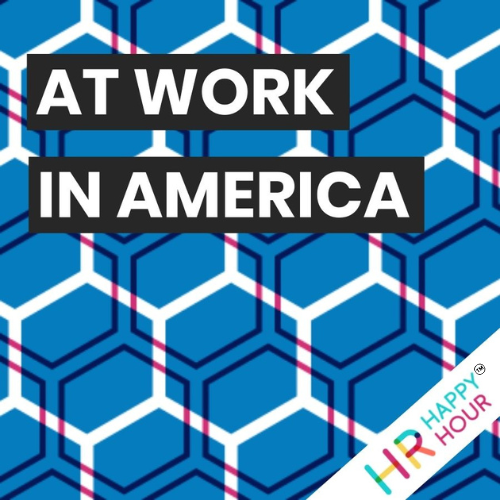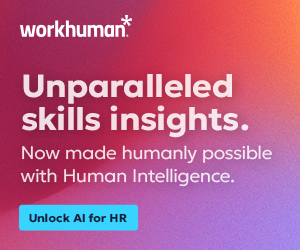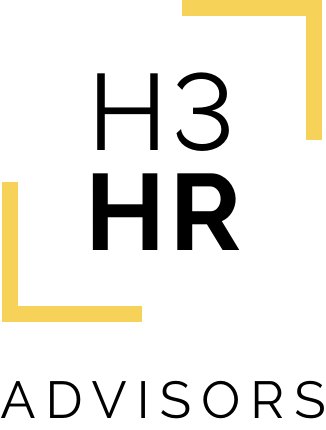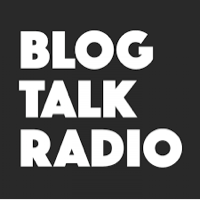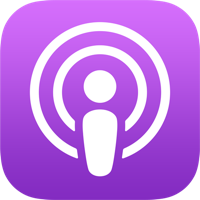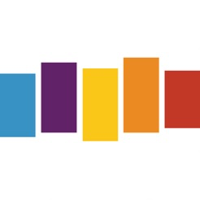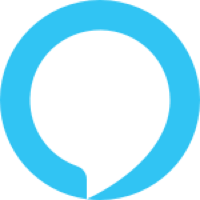Benefits Essentials for the 5 Generation Workforce
Hosted by

Steve Boese
Co-Founder and Chief Data Officer of H3 HR Advisors and Program Chair, HR Technology Conference

Trish Steed
Co- Founder and Chief Strategy Officer, H3 HR Advisors
About this episode
Benefits Essentials for the 5 Generation Workforce
Hosts: Steve Boese & Trish Steed
Guest: Tom Hammond, Vice President of Strategy, Partnerships and Business Development, Paychex
Today, we met with Tom Hammond to talk about comprehensive and diverse benefits solutions for different generations in the workforce.
– Benefits and employee engagement
– Digitization and the employee experience
– Innovative benefits focusing on financial wellness and access to cash
– Improving employee benefits and HR technology
Learn more about Paychex Flex perks here
Thank you for joining the show today! Remember to subscribe wherever you get your podcasts!
This episode is sponsored by Paychex, one of the leading providers of HR, payroll, retirement, and insurance solutions for businesses of all sizes. Are you a business leader or HR manager navigating the complex world of hiring and retaining top talent? Then you need Paychex’s Essential Guide to Finding and Keeping Your Dream Team to discover how to attract high-quality employees and keep them engaged and motivated long-term. Whether you’re looking to enhance employee career growth, improve your onboarding process, or understand the importance of flexibility in today’s workplace, this guide has got you covered. Grab your free copy at paychex.com/awia to unlock the secret to building your dream team today.
Transcript follows:
Announcer 0:00
Welcome to At Work in America, sponsored by Paychex. At Work in America digs in behind the headlines and trends to the stories of real people making a difference in the world of work. And now here are your hosts, Steve Boese and Trish Steed.
Steve 0:28
Welcome to the At Work in America Show. My name is Steve Boese. I’m joined by Trish, how are you?
Trish 0:34
I’m fantastic. Steve, how are you today?
Steve 0:36
I am well, I’m excited. It’s our 15th year of the podcast, anniversary time season, we’ve been recognizing that a little bit. We’ve got a couple special shows on the docket to record with some favorite and featured guests over the year. So that’s kind of fun. So yeah, I’m enjoying that.
Trish 0:57
Yeah, I feel like it’s it’s another reason to celebrate June, we’ve also been celebrating Pride Month, I know we’ve put a couple pieces out about that. So happy to celebrate and recognize people who identify with that and really just do everything we can to support that as well in the month of June. So it’s been a good month.
Steve 1:17
Yeah, excellent. And I think in fitting with that kind of idea of celebrating and you know, kind of looking back, but also looking forward, we are not only having one of our favorite all time guests on the show, Tom Hammond who’s waiting in the wings, who I will introduce formally here in a second. We’re also talking about one of our favorite subject areas that we’ve covered over the years on the podcast, which are benefits, employee benefits and ways employers can offer benefit packages to engage, support and care for their employees. So I love the combination.
Trish 1:51
I do too. And can I I’ll be really honest with you. Benefits was the one thing when I started my career, I started as recruiter, and I remember my boss saying like, is there anything you really just don’t want to do? I was like benefits don’t ever, ever make me do benefits. And it wasn’t until I had that as part of my job. And I’m like, What in the world am I thinking like I was missing out on all of this is HR always wants to be strategic, like benefits is your way to care for people, as you mentioned, but also be really strategic with the way everything from hire to retire right benefits covers it all and you can be super creative. So yeah, I learned a lesson then. And I’m glad we’re sharing it now.
Steve 2:35
Yeah, me too. I can’t wait to the before we welcome Tom. Let’s, of course thank Tom and company our friends at Payches. Of course this episode of At Work in America is sponsored by Paychex were the leading providers of HR Payroll, retirement and insurance solutions for businesses of all sizes. If you’re a business leader, or an HR manager, navigating the complex world of hiring and retaining talent than you need paychecks essential guide to finding and keeping your dream team to discover how to attract high quality employees benefits is one way and to keep them engaged and motivated for the long term. This new guide from Paychex is packed with eight key strategies from offering competitive benefits to leveraging tech and automation to help set your company apart. So if you’re looking to enhance employee career growth, improve onboarding processes, or just understand the importance of flexibility, this guide can help you and help you with your strategy. So here’s where you get it, you go to paychex.com/awia to unlock the secrets to building your dream team today. So thanks to Paychex for that. And of course, thanks to them for all the support.
Steve 3:46
And thanks to Tom for being here. Let’s welcome him a formally. We’re excited to welcome Tom Hammond. He’s the Vice President of Strategy, partnerships and business development Paychex. Today, we’re going to explore the many challenges that businesses and HR leaders face when offering comprehensive and diverse benefits and some of the strategies and solutions to help meet the unique needs of five generations, which is shocking to say that out loud five generations in the workplace. So Tom, first of all, welcome back to the show. Great to see you. And how are you?
Tom Hammond 4:22
Steve and Trish first great to be with you. As always. I’m doing very well. But before I say anything else, I want to congratulate both of you on 15 Incredible Years. I also want to thank you for raising the exposure of the HR profession and for all of the guidance and tips, tricks and expertise that you have delivered for 15 solid years. So thank you on behalf of all the HR practitioners in the US.
Trish 4:50
Thank you so much.
Steve 4:51
Thank you, Tom. It’s a pleasure to be here and to think I started 15 years I was talking about HR and on the podcast, the kids were out playing ball and in the park. And now but no, thank you, Tom, I definitely appreciate all the support. And benefits, Tom, we’re recording this in mid June. And this is really a kind of open enrollment planning season for most US organizations who do open enrollment in the fall and the way benefits has changed a lot in the last few years. So let’s start there, maybe if you could share some thoughts on just some of the challenges organizations are facing with the changing nature of benefits and the changing nature of the workforce?
Tom Hammond 5:37
Well, I think, as with most things, COVID changed the landscape for so much in the HR profession and, and for so many other professions. But benefits have become so impactful and important, due to the real need to both recruit and retain a dedicated and engaged staff of resources to help you accomplish whatever the goal is, of your particular organization or your mission. And just like everything else, the workplace today has really fueled by five generations. And I really, I continue to scratch my head when I think about that. But the research that we have done really outlines the fact that benefits are really unique, and they’re unique to the individual, any HR professional would say one of the most challenging things in his or her career would be to create a robust benefits package that really meets the needs of the vast majority of the employees. And that’s such a challenge today. It has been for four years. So we’re really excited about some of the things that we want to talk to you about today, what we’re looking at and how we are trying to help America’s businesses with that. But it’s such a complicated space, with so much ground to cover, there’s just a long runway to make meaningful contributions.
Trish 7:10
Yeah, I’m so glad that you give that description time, because I don’t think we realize that we would have five generations I think, you know, you just sort of assume you’re gonna wind up with four, or maybe, you know, three, and then the half during your career, right. So things have really changed in the last, you know, two years in terms of both people wanting to stay in the workforce longer or even needing to stay in the workforce longer. Before, I know, we’re gonna dive in deep on a lot of this. But one of my questions when I was thinking about this more holistically, and maybe you can give us your insights on this is, if I’m an HR leader, how, how do I best go about determining what the different generations need? Because, you know, obviously, we occupy one generation, and we might think we know what people need, what are some of your best practices there? I know you’ve worked with tons of of employers who are doing this very thing, what are some of the tips you give to leaders just as a starting off point to thinking about five generations?
Tom Hammond 8:10
First and foremost, we really recommend having an engaged discussion with the individuals that make up your workforce. And you can do that in lots of different ways. We recommend one on one conversations, but we start typically with focus groups, and we pull a diverse set of the population together and just talk to them about what’s top of mind what benefits are actually working, and where are you using them. They’re in today’s technology driven environment, you can get access to who’s leveraging what benefit. But what’s really powerful is when you start to break down the analytics and turn that data into insights on what is that population that’s using that benefit look like and there’s some eye popping opportunities there. One that always comes to mind for me is is the earned wage access. And when you break down that earned wage access, one may traditionally think that someone who needs access to funds may be the predominant user of that. What we’ve found through our research is about 90% of the hourly workers are really interested in access to on demand pay, but for very different reasons. Some, one of the biggest use cases is I have an unplanned expense, but others are really just trying to manage their cash flow in a very efficient way, meaning most people’s mortgage or their rents are due at the first or the end of every month. That doesn’t line up with a traditional pay period very often. So how do I get access to some of this so that I’m not having to try to scramble through that budget process. I was just reading that earned wage access and kind of living paycheck to paycheck if we put two of those together. has now really moved into what I would call higher wage individuals folks making well into this six figures that are struggling with living paycheck to paycheck. So you can get some insights from that Trish. But then it comes down to an awareness. And typically what I have seen is there’s a lack of awareness on benefit packages. For business, there’s of all sizes, one of the things that I’ve constantly struggled with is making sure that my own employees know the benefits that paychecks provides and the value that they have access to. And I found that that is not uncommon in the other professionals that I talk to, regardless of the size of their organization. So I like focus groups to start to get a broader sense of some ideas. And then we go to deeper focus groups to get a sense of what is actually really going to be rewarding, no pun intended to a diverse population of employees.
Trish 11:00
I think those are great tips. I love also the fact that Steve at the top, you mentioned care and the way that that you know impacts benefits time, what you’re talking about is really taking all those insights from your technology, right, that you’re collecting and from the plans, but you’re attaching heart to it, right? You’re you’re making that that personal gesture to someone to say, hey, what’s important to you? And I think you’re right, I’ve thought of HR doing that. But I hadn’t really thought about the fact having each of your leaders even talking with their people reminding them of what they have. So really good tip, I think.
Steve 11:35
It’s a great piece of advice, Tom, and I think even something organizations could do in simply like when you’re structuring or you’re helping leaders or managers, and you’re coaching them through, say, just doing your one on one check ins, right, which most organizations do as a as a semi formal or formal processes. Hey, having a little note reminder or a tickler in those those one on one meeting notes to say, hey, managers, make sure you you know, take some time to mention this benefit, or this new program we have or this new volunteer went on about voluntary benefits on the show today. Sometimes these voluntary benefits which are not medical or retirement or you know, the traditional dental, we may forget about those as well. So I think it’s a great idea to help for managers to be more involved in these conversations with with their teams.
Tom Hammond 12:23
I can go back in my history to the 15 years that we’ve kind of interacted and we always talk about putting the human in human resources. And that’s one of the things I walked away from my discussions with you, for a number of years really resonating with me, and I think data and analytics are so key, but they really are providing the insight so that you can have a human discussion. And you can be listening as a human in your one on ones to understand what is it that you’re struggling with. I had one earlier this week about someone who’s whose dog was coming to an end of life. And that’s such a traumatic experience for someone who’s had such a long life with their pet that brings a lifestyle benefit to the table like a pet insurance scenario that years ago, I didn’t know it even existed. And those are great examples of just kind of introducing the one on ones the focus groups to figure out what would provide value to a diverse set of people. Yeah.
Steve 13:27
Yeah, benefits are they’re such an important part of the employer value proposition and what’s meaningful to employees. I mean, pretty much traditionally, you will see, when we ask, you know, when we look at what matters to employees, right, in terms of where they’re going to choose to work, certainly compensation fair, equitable market matching compensation, we know is going to be primary, right? That’s just the case. But benefits is right there next to it right, typically, right? Because these, these elements of the total value proposition right or the total compensation package are critically important not just to the employees themselves, but here’s why it always resonates with me and it has for years and years and years when I first got involved in the benefits space, on the corporate side, was it impacts their family members and even their pets Tom is a great example, which are their family members to write on certainly are. So the fact that the organization’s benefits, how they what benefits they make available, how they’re administered, the value of those benefits, that’s creates can create a really deep connection to the employee because it involves their family I’ve always felt.
Tom Hammond 14:38
Yeah, I was having a discussion today with one of the the benefits leaders here at Paychex and he was really talking about well being and how do you create a, a benefits package that encompasses the theme of driving wellbeing for the employee so that you can show up and really give your talents to the organization, because we figured out a way to balance the needs that you have as a employee and as a person, and allow you to really unlock your full potential. And I thought that was just a beautiful kind of example of a really great HR leader, thinking about what’s in it for the the HR portion of the organization, the people of the company, and what that means to the productivity of the organization, and ultimately, the end result of profitability and revenue growth or achieving that not for profit status that you’re looking for.
Trish 15:36
Yeah, I love that example. Because I think that had you talked to that same person, maybe 20-25 years ago, you might not have had that kind of discussion. What we’ve made progress on, I think, is thinking about the work relationship. But when you think about any, any relationship, right, with a friend with a partner, it, it has to meet more than just your financial needs, it has to meet your emotional needs and your social needs and your physical needs, right. And I, for the longest time benefits have really been so focused on just the physical well being and not all those other areas. So it’s exciting to hear that this is part of the regular conversation now, especially at paychecks, where you’re thinking holistically about the person’s needs, and what you can do to sort of deepen that relationship. I wonder, Are there examples that you see where digitization is maybe helping I know, through the pandemic, there’s been obviously a bigger focus on that connection we have with, with our colleagues, with our leaders, how has digitalization impacted some of those relationships and how they’re built.
Tom Hammond 16:50
I think it’s completely changed the game. Candidly, when I think back to the pandemic, pre pandemic, we still had so many organizations that their first interaction with a new employee was a stack of paper. And they that paper was what you filled out to get the information into your HRIS system so that you could get someone paid timely, the contracts that were associated with all the appropriate benefits that you were going to apply for. And it literally was stacks of paper. And COVID really changed that when the world transitioned to a remote workplace for so many months. And digitization became the ultimate way for us to actually survive and thrive through that really challenging period of time. Just to give you some statistics, we on boarded about 3 million individuals in the last 12 months, digitally. And as I look back after 30 plus years here at paychecks, that is just an amazing accomplishment. But that’s how life is today. And the digital ability to add your own personal information validate that that information is accurate. And to go through an open enrollment process that is systematically technology driven to allow you to shop and buy for insurance products, as well as earned wage access of bank accounts, the the way that you want your money distributed, that is so different today than it was pre COVID. And it brings just an amazing set of opportunities to both start your employer employee relation in a really positive, polished manner, and allow workers to show up on that first day really engaged to do whatever it is that you hired them to do. So I’m excited to tell you about what we’re doing with the benefits side, but it’s all digitally driven. And I’m really excited about the the impact that we’re seeing that have for businesses of all sizes.
Trish 19:00
Well, as a follow up, you mentioned accuracy. And I know that again, going back in the day, you know if if I filled out my paperwork, and then someone else had to be the person to input that data. It was wrought with errors, right? So just that alone if for no other reason that alone is making that a more seamless, more accurate process. And I think to back to if I’m the HR leader or the HR team, in fact, that gives me time to be more caring, right to craft, to craft messages to tell people why these things are important because now I’m not doing data entry and shuffling paperwork and try not to make mistakes, right? I’m actually able to administer it in a way that’s more caring and conscientious about each worker and make them feel warm and welcome on their first day. You’re right having a pile of paperwork is not more than welcome on the first day.
Tom Hammond 19:54
No, it most certainly is not.
Steve 19:56
Definitely not. At the top Tom we you mentioned the multiple generations in the workforce, right, and part of that is certainly the newest entrance to the workforce, or the younger workers. And honestly, I can’t think of a way you you sort of turn off a new worker who was a young person on their first day at work, or their their first week at work with stacks of papers and firewalls and all of that, right, because it’s so foreign to that generation. Certainly, their entire existence is mitigated through, you know, phones and devices and things like that. And it doesn’t have to be that way. Right? That’s part of the lesson we’ve learned for exactly, for years of certainly working with, with our friends at Paychex, and seeing all the innovations that they’ve created and put out into the market. And one of the themes that I’ve talked about, both on this show and other things I’ve done for whatever X number of years started in this space is, I think the biggest change in technology and corporate enterprise kind of systems for me, right in the 20. More than 30 years I’ve been doing this is, for lack of a better phrase, the democratization of enterprise level, top level grade technology. But meaning it’s now available to organizations of any size. And I literally mean any size, right. And one of the things we wanted to talk about, you know, we could talk with Tom and Paychex about that, from a payroll perspective, from a benefits perspective, from your perspective, Victor’s retirement administration perspective, there’s loads of examples there. But today, we wanted to talk about benefits, and specifically some new innovations. paycheques is, is bringing to market to really kind of continue to emphasize a these things, these capabilities, these benefits are available to organizations of any size. And I think that’s, again, to me, the biggest thing, forget about the cloud, who cares, right? Mobile devices, that’s good, too. And AI is fun, right? We’ve talked a lot about that in the last couple years. But the ability for organizations of any size down to micro employers trash like two, three employees, right? To have access to this time, I’d love for you to maybe just philosophically share a little bit of maybe if you got a comment or reaction to my little speech, but also then let’s talk a little bit more about benefits specifically in this domain.
Tom Hammond 22:21
Well, so one of the things I love most about Paychex, if you can just give me the 30 seconds is Tom Goldstein, who was our founder more than 50 years ago, and the story of the company is really unique in that he was selling payroll at the time for a competitor. And he would drive down Main Street in any city in the United States. And he’d have to pass 100 businesses to get to the one that he could sell payroll to, because at the time, no one introduced payroll to micro and small businesses, it was really, he needed to be well into the hundreds to actually take advantage of an automated Payroll solution. And with that, he left created paychecks. And here we are today, what we’re doing it from the benefits perspective, is following that same path and that same journey. And for the last 50 years, we’ve been trying to take enterprise concepts and bring them into the small the micro and the mid market, then what we’re introducing is, is something called paychecks, perks. It’s an enterprise level, digitized, curated buying experience for employees of paychecks clients, and it really serves as a augmented set of benefits for businesses that are already offering benefits. And for many, it is the first opportunity to offer their employees, a curated digital buying experience for things like voluntary benefits and lifestyle benefits. And those could be critical illness, hospital indemnity, short term disability Term Life, lifestyle benefits, more like pet insurance, legal plans, identity theft, auto and home. But then rounding that out with things like earned wage access or pay on demand, we’ve tried to take the friction out of that for the employer, where you’re using our time and attendance or a time and attendance solution will provide that employee with what they have available to actually take. And that is funded by a partner of ours financial wellness, which is an opportunity to to learn about how to save and invest appropriately. And then a bank card, a digital checking and savings account. And honestly, we just we did research to say generationally 65% of the Gen Z workers believe that their employer should be responsible for helping them achieve higher levels of financial wellness and literacy. That was an amazing finding for us. So building that in to a well rounded benefits package. And then we’ve talked about the access to cash. But voluntary benefits was really something that kind of caught my eye. About 63% of the surveys that we completed, said that they’re likely to participate in a voluntary benefits package. And so we started looking at our own data inside of paychecks, both within our PEO, and our, in our corporate and nationwide set of employees, we had about a third of them that were participating in dependent life or optional life, about 20% of them focused on legal. And then when we looked in our PEO, which has millions of employees within that in our ASL, we saw similar numbers. And so we thought, okay, what happens to all the other businesses that that aren’t offering these today. So we created this digital curated experience to try to bring these enterprise benefits to the micro into the small and the mid market in a digital environment. And we’re really excited to bring that to the market and help American businesses recruit and retain and help American workers get access to things that they may not have had access to in the past, regardless of the size of their employer.
Trish 26:13
Thank you for creating that to you and the team. Because I think a lot of the things that you mentioned there in terms of voluntary benefits, or even just education around bank accounts and access to wages, and how to financially plan for different purchases, potentially, those are things that in human resources in the time I worked in HR were one offs, right, someone would come to HR and say, I don’t know, how to buy my first home, how to buy my first car, how to do this, how to do that. And we were trying to either teach them ourselves or create some sort of training. And also, when you’re talking about that access to pay, you know, I’ve worked with dustless workers for many years early in my career, and we would do training sessions with them. Because many had never, well, they certainly didn’t have cell phones, and they didn’t have even maybe the education or someone at home, to have taught them about sort of these, what we considered life skills. So knowing that you’re providing that stability, for businesses of all sizes, to be able to turn to that or even have the employee help themselves, right, that’s huge. For these workers, especially ones that may not have had access from anyone else in their life might not have come from home or school. Right? What, what kinds of things I know that, you know, in the 50 years that paychecks has has been here, you’re always coming up with sort of new and inventive ways to both engage workers and the leaders that they you know, they partner with? Where does that come from? Like, I know, you mentioned the founder, I’d love just to know, sort of, for people that might not be familiar with the culture of paychecks. And that culture of innovation and kind of where do you think that comes from? And the people there that are thinking strategically about designing these solutions?
Tom Hammond 28:06
Well, I think it’s it starts with an entrepreneurial mindset. And if this was our small or our medium size, or our mid market size organization, what should we have access to? And that culture has been something that’s been here. From the first day I walked into the organization and it hasn’t changed. It’s really about how do we look at things and democratize may be an appropriate word? I’ve never thought of it that way. Trish, but that’s the term that you used earlier. What Why can’t a micro business have access to enterprise like tools and solutions? And we’re constantly thinking that way? How do we bring these concepts to market? And then how now it’s really a thought process around? How can we digitize it so that it is frictionless for the employee, and provides really no friction for the employer. And the more things that we can do that way, we’re not looking to pile tasks on an employer, meaning I need to get HR involved, or I need to get the owner involved to position or communicate, how can we do it digitally. And like I said, COVID really changed the game because it it introduced the concept and it made us raise our game in terms of customer experience and employee experience. So I really do think it’s a culture of innovation that we have focused on and I appreciate you guys recognizing us for that. We have great people here that come to work every day trying to find solutions like this.
Steve 29:32
tom, thank you for that. I always felt that way. I have a long history of working with Paychex even going back to when before age three before all that for a lot of things. I was a company of one just me for a while and I rang up Paychex and Paychex did my payroll for me from my company of one but it was great. Appreciate it. It’s the Yeah, it was awesome. I appreciate that. But beyond that I for us, Trish I know we’ve focused a lot on access to opportunity in general as a theme on the podcast over the last couple of years, and to me, this is an extension of that right? Access to the opportunity to have a fulfilling, engaging, comprehensive kind of workplace experience for everyone. No matter who you work for, where you work, what job you do, whether your employer is got 100,000 employees, or whether they have 15. Right, that you should be able to have access to all the opportunities, benefits, innovation, right, that’s happening in the market, and why not right? Why how, how should the size of the company you work for preclude the kind of life you get to live right, it makes no sense to me. And it doesn’t make sense. And I think what the team at patriots continues to do is really help organizations and individuals kind of have a more fulfilling workplace experience and an overall better a better life. I, that sounds a little, I don’t want to be waxing philosophical here. But it’s really important to me, if it’s meaningful, to me, as an observer of this, it’s doubly important to you and the teams that Paychex. And I’m really just excited for what you guys have done with this next set of innovations.
Tom Hammond 31:25
What I’m really excited about is that we’re just scratching the surface. So we’ll roll out, we’ve rolled out these first set of benefits that financial wellness and access to cash and access to a card, the voluntary benefits, the lifestyle benefits, but what we really created is a digital opportunity to consistently keep the benefits package fresh. And the way that we’re approaching this is at point of a customer adding a new employee, that employee will be able to, through their onboarding experience, see the offers that are available to them, and digitally shop and buy. And we will constantly keep this thing updated as the world evolves. So if a new benefit starts in the next couple of months, that is really exciting. We’ll do the heavy lifting for you. And we’ll figure out who the best partners are. For those, we’ll create the digital integration that’s required. And we’ll put it into that same repeatable workflow so that employees of our clients have access to everything that the largest enterprises here across the US have access to. And I’m really, you have no idea how fun that is. You said it Trish, like benefits is where you make a difference. And this has been a really, really enriching and fun experience.
Trish 32:46
I think you know what, and as you were talking, I’m sitting there thinking about the solutions that you’re creating. It really goes all the way back to that leader and employee relationship, right? Where, you know, Steve, kind of at the time, you’re talking about, like, leaders are the ones that sometimes don’t know what all the benefits are. So I’m not going to be able to go tell someone on my team maybe, because maybe I don’t know, well, if it’s being served up to me in a digital way myself, Wow, you can incorporate that very easily into your weekly check in or your one on ones are many different ways, right. So again, you’re sort of arming people with the information that they need when they need it, instead of going searching for it. And I think that’s the biggest shift, I can imagine from my time of being a pregnant practitioner to being an analyst is I worked in the time of people had to go search for it, or I had go search for it. And now you’re sort of flipping the script on people. And I love that I was talking with my daughter, and my niece, and my niece actually is working for someone she uses paychecks. But we get we get good feedback from Gen Z, you know, 1920 year olds, 21 year olds, 20 year olds, because it’s giving them information that they want, when they need it before they even know they need it before they know what it’s right. They don’t even know that like I was talking with my daughter, she didn’t know that you would get health benefits from many employers. It’s like we assume if we’ve been in the workload a long time like Well, that’s we don’t need to talk about that, that everybody knows. No, actually they right. So again, back to having it digitized and served up to you and what you’re able to partake in if you choose to game changer.
Tom Hammond 34:40
Just think about, think about the life events that happened to an individual throughout his or her career, or even just a physical calendar year. And the the opportunities that would come to customize specific things that would make a difference to that individual. Going back to the key word of individual there. Whether it’s a birth or an adoption of, of a son or daughter of a life event, you name it. And to be able to position this might be a value to you when we’re not quite there yet, but we will get there. And we will continue to expand the benefits that are available to provide those unique opportunities for employees and give one more tool, or better yet to take one more activity off the shoulders of a really overburdened HR or business owner. So should be should be fun. And again, you guys started today with its planning for open enrollment season, and just the data that’s coming out of this exercise of what matters to people and being able to look at it. And then to take that and be able to leverage that with our HR professionals here to say, look, we have hundreds of 1000s of clients and employees that are leveraging this particular benefit. This is one you should be promoting more, because you have such a group of your existing staff that we think would would value that those are really powerful insights as well.
Trish 36:14
Yeah. And that only comes from from having as many customers as you do, really, right. People, right, having that data available. If I’m a small business or even a midsize business, I won’t, I won’t know that. Right. without, without that partnership with Paychex.
Steve 36:30
There’s a lot of really good positive elements to the story, right? The access to the technology, the access to these benefit offerings, the the ability for organizations to honestly better compete for talent and retain talent in a competitive environment. What is it Tom, half half the US workforce works for a quote unquote, small or midsize business? Right? Right. So this is a huge issue, right? And it’s it’s easy to get caught up in what we do especially right, and that very, enterprise global companies and hundreds of 1000s employees, and those things are important. Those people are important. Yes. But this really impacts so many people, just in every town in every city people exactly every day, right? The folks who are in the stores, and you’re doing the landscaping and the small manufacturing shops, and, you know, and on and on and on. So I’m just I’m excited to help to talk about it, and also to share it with our audience as well. So Tom, well, we will be respectful of your time as well, and just say, thank you for being with us today. And for folks who want to learn more, certainly, we’ll send them to paychecks.com. We’ll give them a link in the in the show notes to learn more about what’s going on with paychecks, flex paychecks, flex perks. And just thanks again. For all you personally for being such a great friend of the show. And to the whole team of Paychex for being such great supporters of us. We can’t thank you enough.
Tom Hammond 37:58
No, thank you for that Steve and Trish and congratulations again on 15 amazing years and all that you’ve done for this entire world of HR professionals and continuing to elevate the profession. Appreciate that more than I can say.
Steve 38:12
Thank you so much. Thank you. All right, finish great stuff. I love Tom, I could talk to Tom for another two hours. Oh, Tom’s boss won’t allow me to do that. So we’ll have to let him go. But Trish, great to see you. It’s exciting. 15 years will great shows coming up as well. So I hope folks check this out. We’ve got so many guests lined up to come and say hello in the next couple of weeks. It’s very exciting.
Trish 38:35
We do we’ve got some of the OGS coming back from you know those first few episodes. So it’s going to be really exciting to see not just how the world has changed in 15 years, which is quite a bit but how have their lives change how their roles changed. So excited to get some of the OGS back on the show.
Steve 38:51
Yeah, me too. It’s gonna be great stuff. So alright, so that’s it for today’s show. Thank you again, Tom Hammond. Thanks everybody Paychex. Thanks to you Trish, make sure to go to HRHappyHour.net for all the show archives. Check us out everywhere you get podcasts, including YouTube channel, our YouTube thing is blowing up by the way. So thanks again. My name is Steve Boese. We’ll see you next time and bye for now.
Transcribed by https://otter.ai
Talk to us
If you want to know more about any aspect of HR Happy Hour Media Network, or if you want to find out more about a show topic, then get in touch.

